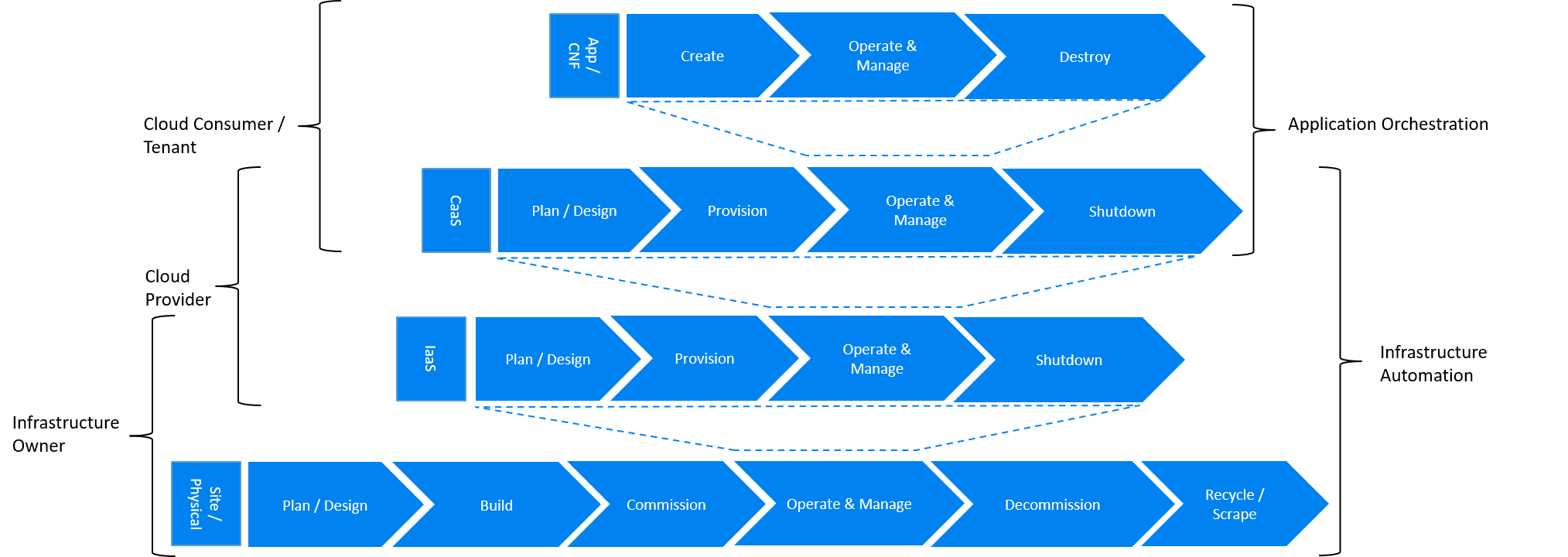
In a typical telecom operator environment, infrastructure Life Cycle Management is highly complex and error-prone. The environment, with its multiple vendors and products, is maintenance expensive (both time and costs) because of the need for complex planning, testing, and the out-of-business-hours execution required to perform disruptive maintenance (e.g., upgrades) and to mitigate outages to mission-critical applications. Processes and tooling for infrastructure management across hybrid environments create additional complexity due to the different levels of access to infrastructure: hands-on access to the on-premise infrastructure but only restricted access to consumable services offered by public clouds.
Life cycle operations, such as software or hardware upgrades (including complex and risky firmware updates), typically involve time-consuming manual research and substantive testing to ensure that an upgrade is available, required, or needed, and does not conflict with the current versions of other components. In a complex and at-scale Hybrid Multi-Cloud environment, consisting of multiple on-premise and public clouds, such a manual process is ineffective and, in many cases, impossible to execute in a controlled manner. Hence, the need for automation.
The goals of LCM are to provide a reliable administration of a system from its provisioning, through its operational stage, to its final retirement. Key functions of Infrastructure LCM:
The following diagrams provide mapping between different stages of the lifecycle automation across all layers of the stack to owners of infrastructure and cloud and the tenant as the consumer of the cloud services in three very different scenarios: applications running as containers within virtual machines (CaaS on IaaS scenario), application running as containers on bare metal (CaaS on BM scenario) and more traditional view of applications running as VNFs within virtual machines (IaaS scenario). The diagrams define the scope of the Infrastructure LCM Automation for each of these scenarios. The dotted lines symbolise the interactions between the layers of each of the model.

Fig 1. Infrastructure Automation in CaaS on IaaS scenario
In the CaaS on IaaS scenario, the Infrastructure Automation scope covers the Site/Physical layer, IaaS layer and CaaS layer. From the lifecycle perspective (the left hand side of the diagram), Site/Physical layer is entirely owned by the Infrastructure Owner, the virtualised infrastructure layer (IaaS) is shared between the Infrastructure Owner and the Cloud Provider. Similarly, the container orchestration layer (CaaS) is shared between the Cloud Provider and the Cloud Consumer / Tenant. These relationships can be illustrated by a situation, where a telecommunications provider owns the physical infrastructure on which an external cloud provider runs the virtualisation software (hypervisor). Sharing CaaS layer between the Cloud Provider and the Cloud Consumer reflects the fact that the container management/orchestration software like Kubernetes is lifecycled by the Cloud Provider (for instance when scaling out containers) but also by the Cloud Consumer because of the very close lifecycle relationship between an application and a container in this model, where for example destroying an application means also destroying related containers, and hence it can be considered as a part of application orchestration.

Fig 2. Infrastructure automation in CaaS on BM scenario
The main and obvious difference in this scenario is lack of the IaaS layer, and hence the scope of the Infrastructure Automation is limited to only two layers: Site/Physical and CaaS. From the lifecycle ownership perspective, the CaaS layer is now shared not only between the Cloud Provider and the Cloud Consumer (for the same reasons as in the CaaS on IaaS scenario) but also with the Infrastructure Owner. The latter fact is related that in the bare metal deployments, because of the lack of the hypervisor, the CaaS layer is much more dependent on the underlying physical infrastructure.
Essential foundation functional blocks for Infrastructure LCM automation:
Automated LCM uses Representation Model to:
Automated LCM uses Repository functions to:
Automated LCM uses available IAC Software Versions and Dependencies component to:
Automated LCM uses Orchestration Engine to: